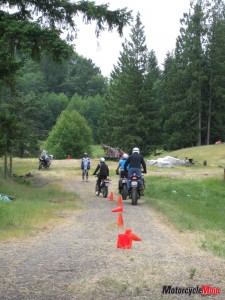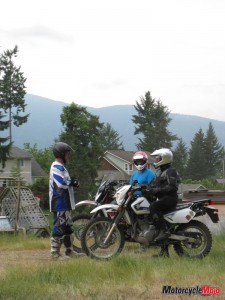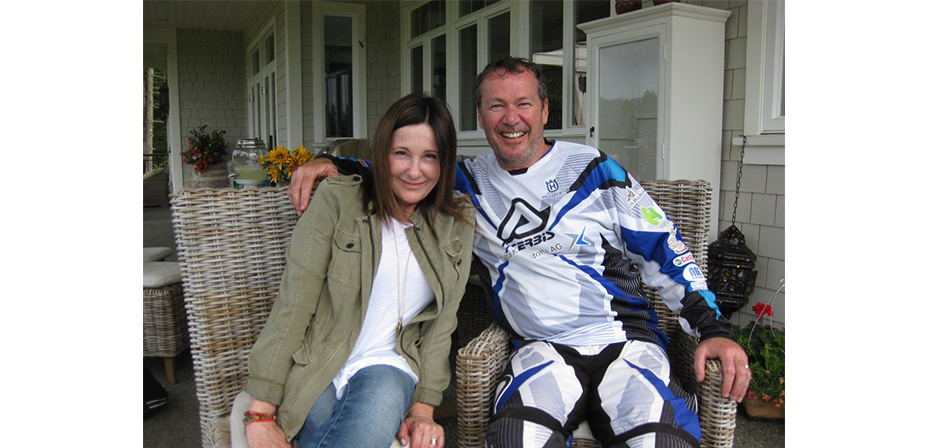At age 57, it takes some grande cojones to compete in rallies around the world against the very best off-road riders, but a simple thing like that wouldn’t slow Don Hatton down
The property at Don Hatton’s ranch is an adventure motorcyclist’s playground. A series of trails has been worn into tall, green grass. Hills and valleys undulate through the farm in Cowichan Valley, British Columbia. Cows munch unimpressed in a shady corner.
Hatton has led us down a trail with some tight turns, steep descents and sudden climbs on the wet grass. I’m on my KLR650, and three other riders are on DR650s and a lone KTM 1190 Adventure. Traction is hard to find as we follow Hatton on his BMW 1200GS Adventure. We slip and slide. The KTM rider, who’s planning to join a guided motorcycle tour in Southern Africa, unceremoniously dumps his bike when his rear wheel can’t grab any grass. He tumbles down the hill. It takes Hatton, the rider and another student to lift up the big 1190.
“That bike is a pig,” the KTM rider barks in frustration. He’s clearly fatigued and in need of a break. Hatton gives him some encouraging words.
The World’s Largest Rallies
 I can’t help but think of how many times Don Hatton has had to face this situation, on his own, on much more hostile terrain, in the middle of the piste of the Dakar Rally. As the Canadian with the most international off-road rally experience to date, Hatton is in something of a category of his own and ideally suited to be teaching this adventure riding course, which he’s been doing on his ranch since 2007. The three riders and I are his students and have been riding courses and running drills for two hours.
I can’t help but think of how many times Don Hatton has had to face this situation, on his own, on much more hostile terrain, in the middle of the piste of the Dakar Rally. As the Canadian with the most international off-road rally experience to date, Hatton is in something of a category of his own and ideally suited to be teaching this adventure riding course, which he’s been doing on his ranch since 2007. The three riders and I are his students and have been riding courses and running drills for two hours.
Hatton has gotten to actually compete in the Dakar Rally three times (another time, the rally was cancelled altogether). He has completed the Shamrock Rally of Morocco, where he finished fourth, as well as the Abu Dhabi Desert Challenge, the Tunisian Rally, the Sardinian Rally and the Baja 1000, where he again finished fourth in his category. The last time he competed in the Dakar Rally, his teammate on the Rally Raid Canada team was Dakar veteran Simon Pavey. Hatton was a member of Cyril Depres’ Factory KTM team when he competed in the Sardinian Rally. He also acquired quite a history of motocross racing on Vancouver Island before his international rally career got going at the age of 50.
We all ride our bikes to the cattle gate, open it up and leisurely make our way up the hill to the deck of Hatton’s ranch house on this mildly overcast day. A lovely lunch has been set out on the table overlooking the generous farm property. After enjoying some sandwiches and sipping on lemonade, Hatton lets slip some news.
Fifth Time’s the Charm?
“My 2016 Dakar application is in process,” he informs me with a grin.
He has yet to receive the final word, but Hatton of Duncan, British Columbia, plans to go after the finisher’s medal again, at 57 years of age. But age has never deterred Hatton, only physical setbacks from earlier rally injuries.
“If all goes well,” he says in anticipation, “and my fitness level gets to where I want it to be, we’re going to give it one more shot.”
He now hopes to compose a team under the Rally Raid Canada name and apply and prepare himself to compete in smaller rallies in the meantime.
“Nothing’s final of course until we’ve been accepted. It’s very difficult to get into the Dakar these days.”
But in raising the funds to compete in such a pricey event (the basic motorcycle registration fee for the Dakar Rally sits at the equivalent of just over $20,000), Hatton has found an interesting sponsor – his own local business: Hatton Insurance Agency.
“I happen to know the president. I sleep with the secretary-treasurer,” he jokes, referring to himself and his co-worker-wife, Natalie, who has been part of his support team in previous rallies, including the Dakar.
Developing a Plan to Help Others
 You might find that it’s an interesting profession to be in while considering competing in one of the most dangerous races in the world. But for the past two years, Hatton has been building up his Duncan insurance business, and he’s at the point now where his interest in insurance, motorcycling and rally racing are coming together.
You might find that it’s an interesting profession to be in while considering competing in one of the most dangerous races in the world. But for the past two years, Hatton has been building up his Duncan insurance business, and he’s at the point now where his interest in insurance, motorcycling and rally racing are coming together.
“I’ve been able to take my skills as a motorcyclist and my profession and create an insurance program for on- and off-road motorcycles that’s starting to take off.”
But being able to sponsor other motorcycling events is what Hatton really gets a charge from, helping other riders and start-up events, like the Squamish Motorcycle Festival, where he also is a guest speaker and leads a dual-sport ride; and the MX101 Yamaha Factory Motocross Team racing in the 2015 Canadian Rockstar Energy Drink Motocross Nationals.
But in as much as things are working out at home, Hatton has a tumultuous relationship with the rally he has dreamt of completing for many years. What bothers him is what he calls the “Dakar Curse.” His previous attempts have met with near-death experiences.
If It Weren’t for Bad Luck . . .
In the 2009 Dakar, Hatton felt he was 100 percent prepared, but overconfidence and inexperience set him back.
“I went off a jump that I had not seen at 140 km/h,” he admits. “I had some very serious injuries and and a lot of broken bones.”
Hatton later learned he had been unconscious on the course for two hours. He spent seven days in intensive care. He checked himself out of the hospital against his doctor’s advice. Hatton believes he has never really recovered from his injuries from that 2009 Dakar experience.
In the 2013 Dakar, Hatton set out, with teammate Simon Pavey, on a “prologue,” something of a qualifying run where riders were sent on a 13 km sand dune loop, with the completion time determining starting order the next day. A poor finishing time resulted in Hatton starting out near the back, closer to the cars and trucks and far away from his teammate. A few days later, a truck caught up with him in the dunes, wasn’t using its sentinel warning system and plowed into the back of Hatton’s Husqvarna, setting off a chain of events that would end his Dakar ride only four kilometres away from the end of that day’s stage.
“It is always this snowball effect that leads to disaster in the Dakar,” Hatton says with a sigh. But there’s some more wisdom he’s picked up from previous rallies.
“Except for 2009, the bike I was riding was one that I’d never ridden before,” he explains. He tells me there were budgetary reasons for this. But there’s a certain amount of trepidation in his voice when he describes the start of the Dakar on a new bike he’s just been introduced to.
“It’s the first time I’ve touched hands on the bike I’m riding,” he says, his hands outstretched as though gripping the bars.
Being on a bike that was like nothing he had ever ridden on the sand before sent him into the rally unprepared, putting him farther behind and nearer the aggressive cars and trucks.
“I was in the middle of them, and from then on life was a disaster.”
Add to that a navigational mistake and Hatton was in a nightmare. He compares the sand of Peruvian dunes to talcum powder, and the Husqvarna rally bike a totally different bike than the one he should have been using.
Preparing to Compete Again
Hatton does believe that the Dakar is 80 percent luck, but he’s determined to be more prepared with his physical condition, his team and, most importantly, the bike. He hasn’t decided on which make he’ll be using in 2016, but it will be one that he has been using for training.
He has a plan: go back to the basics and do what got him Dakar-ready in the first place for 2009.
“I’ve started a new training program and I’m spending a lot more time on my bike riding for fun.”
And part of the fun is sharing what he has to offer with other riders, as he’s doing on this day, preparing them for a ride that will take him along the familiar roads of his own training. Fire roads, forest service roads, trails – the paths that snake through the Cowichan Valley in a complex network. These are Hatton’s training grounds. Although limited in that they don’t match the terrain or environment of Peru, Bolivia or Argentina, they do give Hatton the ability to ride aggressively off-road for an extended period of time and build up his endurance.
Paying It Forward
“You bring guys in and many times they can’t get around the field, and by Day 2, we’re going on some pretty extreme adventure riding. And the smiles on the guys’ faces, even though they’re exhausted by the end, is worth every minute of it.”
Clearly he enjoys the process of passing along what he’s learned from his international rally experiences to his students. What’s clear, too, is Hatton also sees himself as a rider on a level field with other riders, and part of a community of riders, someone who is still learning himself, despite his impressive abilities and experiences racing around the world.
“By the end of this course,” says Hatton, “they know how to ride properly, which means they’re probably not going to get injured. Which is really good for our sport. The less guys that get injured, the less publicity we get, the better it is.”





















